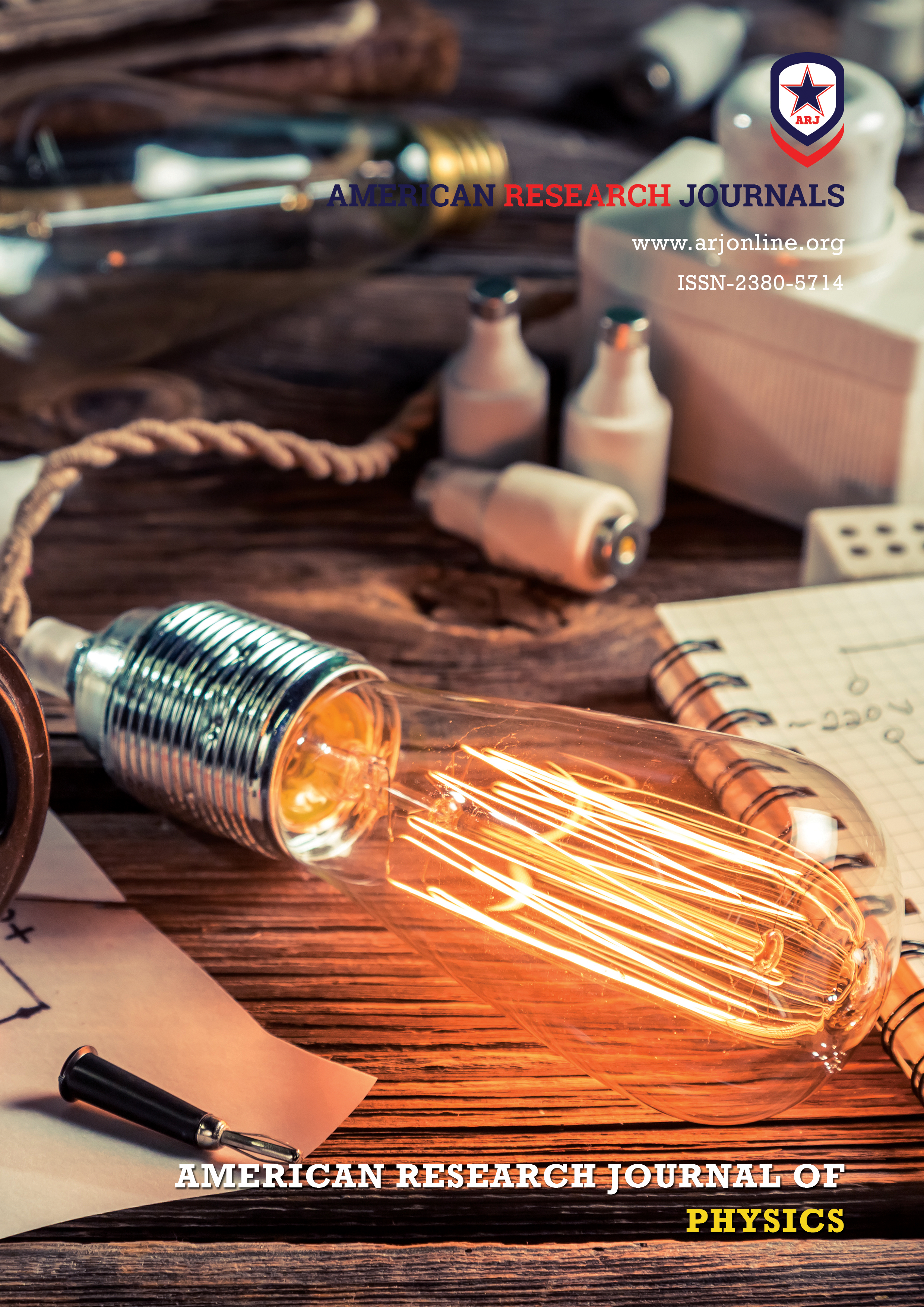Study of Transient Creep Characteristics of Zinc-40Aluminium And Zinc-90 Aluminium
Pdf : 18 Views Download
Citation: M. Y. Salemâ€Study of Transient Creep Characteristics of Zinc-40Aluminium and Zinc-90Aluminiumâ€. American Research Journal of Physics, vol 6, no. 1, 2020, pp. 1-8.
Copyright M. Y. Salem. This is an open access article distributed under the Creative Commons Attribution License, which permits unrestricted use, distribution, and reproduction in any medium, provided the original work is properly cited.
Abstract:
Zinc-Aluminium samples were manufacturing noteworthy, also substantial. Zinc-Aluminium samples possess wonderful powered advantages, altitude intensity, straightforward final touches, strength for ligation completely through the structure, and, adequate; transient creep Characteristics for Zinc-40Aluminium and Zinc-90Aluminium alloy is investigated during several running temperatures (T) eight degree extended between 523 until 593 K in 10 0C steps and under three varied constant utilized stresses (σ) equal 14.05, 17.12, and 20.23 MPa. The magnitude of β and n in the present study is distinctly linked on the creep test circumstances (T) and stress (σ) as εtr = βtn. The coefficients n is raised by rising T regardless of the utilized stress (σ); while β is reduced by growing (T) and /or stress (σ).The Zinc supplement from 10% until 40% refines the precise structure, enhancing the mechanical advantages, and decrease in creep reluctance is recognized i.e; elevate the ductility; therefore the second alloy Zinc-90Aluminium is more strengthening than first alloy Zinc-40Aluminium.Keywords: Aluminium-Transient creep; microstructure; Zinc.
Description:
Introduction
Creeping (stress time) is the ability of specimens to patiently advance and is wholly warp permanently through the utilized loads. It can happen as a result of long-term display to elevated loads grade which remains less than the substance’s production density. Testes is extra pointedly in materials which is uncovered to warmth for extended duration and ordinarily rise as it approximates its melting temperature. Deformation rate depends on material discriminatory, time, temperature and load utilized (utilized loads and duration). Disfigurement be extremely considerable in order for installation and protracted capable for assignment, till instance a turbine knife creep so as to pleasure give rise to the knife for touch the hat, leads to the knife to unsuccessful. Creep is generally owing to interest in designing and metallurgists while estimation installation so as to function for altitude loads and altitude degrees. Creep is a disfigurement technique so don’t frame a defeat technique. For instance, reasonable creep is occasionally become in specified due to it mitigate tautness loads so as to may donate broken.
Technically Zinc-Aluminum alloys are notable and technologically indispensable. They possess excellent mechanics distinctives, altitude intensity, and force for sponsorship wholly through the projectile is comfortable [1-3]. Considerable Zinc- Aluminum specimens are also used for constitutional objective, and its samples pose a major problem due to their versatility in manufactures [4], wherever reluctance creep will be an important feature. The commercial zinc-based alloys Zinc-12Aluminum and Zinc-27Aluminum were the first major zinc alloys developed. And are vastly utilized as beneficial engineering manufacturing samples for cutting or structure in manufacturing tools, scientific preparation and home device [5].
A labor has been done to improve potentially slipresistant alloys; it is utilized in structural applications where conventional zinc alloys cannot be utilized. This led to the development of improved Zinc-12Aluminum-4Cupper and Zinc-27Aluminum alloy. Along the crawl, there are other advantages of Zinc-12Aluminum-4Cupper alloys including hardness and wear resistance, which are claimed to be better than that of traditional Zinc-12 Aluminum and Zinc-27 Aluminum alloys. Zinc-based materials jointly an altitude quantities of Aluminium (distributing as Zinc-Al materials) comprehensive a combination of molding specimens which possess confirmed in a diversity of confront accomplishment.
Zinc-Aluminium molding groups are Zinc-8Aluminum, Zinc-12Aluminum and Zinc-27 Aluminum. These materials integrate elevation and toughness, and perfect technique jointly pretty sturdiness and apparel abrasions which are predominatingly ascendant to standard bronze bars. Zinc- Aluminium materials are utilized for the industries of distinct effective equipment analogous hinge and teeny gears, and also projection parts as handles, taps and fittings. These specimens, warrantor a perfect elasticity between performances and production costs. They also display perfect corrosion and wear reluctance [6]. The existence of Aluminum, in convenient percentage, encourage the liquidity of the samples, raises the mechanical distinctive and promotes the corrosion reluctance in mild offensive surroundings [7]. The study of the consequences, a regular realization is indispensable to comprehend the creep behaviour of Zinc- Aluminum alloys. Nevertheless, regardless of the precocious heartening outcome, there is a large body of literature that is certain in order to piling up Zinc-comprehensive materials experience between a primordial destitute oxidation reluctance and slight moistening characteristic, in any case of the treatment approximation utilized [8–11].
Experimental Procedures
In the present work Zinc and Aluminum of very very tidiness may reached 100% were utilized for attending dual Zinc-40Aluminum and Zinc-90Aluminum based alloy by vacuum melting as pure accessories. The smelting manner is performed employing space bracket heater employing Ar gas of crest tidiness for reproduction a penis-such as example with a radius about 0.4 cm. Slushy mingle is conformable at 1066 K for 150 minutes and then layed to a iron form for providing hard casting shape. Subsequently, the specimen is plasticized at 303 K until 9600 minute pre-tests. This treatment permitted a teeny amount of cereal growth to be contained and cereal steadiness [12].
A refrigeration rate of 4-7 K / s was done, to inspire the microscopic structure usually establish in teeny welding connexion in precise electronic beams [13]. As a result, chemical dissection is performed with a volumetric technique to assess the exact installation of the casting alloys. The
chemical combinations of the mixture are listed restricted in Table 1. And Fig. 13
Creep disfigurement is achieved during overheat piece specimens of diameter 5cm standard extent. The lingeringly cooled specimens were crept under constant utilized loads extended between 14.02, 17.12, and 20.23 MPa at temperatures stretched between 523 until 593 K in 10 K steps utilized an
imitative style test instrument [14]. The reliability of heat estimation is of the domain ± 1K. Strain estimation is done through a reliability of ±1x10-5 m. The morphology of testes mingles was investigated utilized Scanning Electron Microscopy (SEM). Every sample is handed furbished by 1/2 meters of Al2O3 molecules and jointly drilled 2% hydrochloric acid, 3% HNO3 and 95% (volume%) C2H5OH solution. Knowing the internal structure
of specimens were achieved by standardizing X-ray diffraction (XRD) at 40000 volt and 0.020 micro ampere utilized Cu K radiation through the deviation angle (2θ) between 100 until 1100 and estimate the velocity of stationary scanning Phase identiï¬cation of the specimens.
Results and Discussion
In this paper we study the transient creep; the transient strain is specified using this formula [15]:
Strain transient = β timen (1)
anywhere Strain transient is transient creep strain, β and n are constants relying on the elementary condition. Figs.(1-3) a and b studied typical creep curves of the two tested models mingles Zinc-40 Aluminum and Zinc-90 Aluminum expressed as strain against period during stationary inspection degree extenting between 250 0C till 320 0C in eight degree proceedings in presence of utilized loads scale from 14.5, 17.12, and 20.23 MPa for the two tested materials.
To compare the effect of Zinc addition of Zinc-90 Aluminum mingles in the running research, Fig.(1c) symbolized straintime correlations for difference between inspection of mingles owing to first load fourteen MPa, it is evident such Zinc-40Aluminum mingles is further superplastic than Zinc-
90 Aluminum by about 85%. In fig. (2c) it is evident that the Zinc-40Aluminum mingles is further superplastic than Zinc-90Aluminum by about 120%. In Fig.(3c) the Zinc-40Aluminum alloys is additional superplastic than Zinc- 90Aluminum by around 94%.
Our correlation through ln (straintransient) with ln(time) donates rectum bar such explained in Figure (4-6). Constant n is determined by using slope of the relation ln (straintransient) with ln(time); it is organized as widespread among 0.45 until 0.89 for Zinc-40Aluminum, stretched
between 0.35 until 0.73 for Zinc-90 Aluminium mingles as symbolized in in Fig.(7); the value of n indicates the Zinc- 90Aluminium piece is additional strengthening than the other mingles
lnβ = (lntime2 straintransient 1 –lntime1 straintransient 2)/lntime2-lntime1 (2)
Magnitude value for beta coefficient possess stretchedthrough -7.3 until -1.54 to -7, and -7.0 until -1.56 for two
mingles; respetively; it is symbolized at Figure(8). The following equation utilizing to describe estimated activation enthalpy for the prsent work [16].
ε tr = ε0 + tn exp{-Qtr/KT} (3)
Stimulated energy for present samples Qtr possess values around 61.11 to 73.79 kilo joule per mole in case of Zinc-40Aluminum and until for 73.799 and 84.79 KJ/mol for Zinc-90Aluminum in low and altitude regions respectively i.e value of Zinc-40Aluminum is less than the send mingle , as
shown in table.2 as represented in Figs.(9,10). These values of activation energy indicated that fist sample is very elastic than the second samle in two regions of study due to Zinc- mingles; respetively; it is symbolized at Figure(8).
The following equation utilizing to describe estimated activation enthalpy for the prsent work [16].
ε tr = ε0 + tn exp{-Qtr/KT} (3)
Stimulated energy for present samples Qtr possess values around 61.11 to 73.79 kilo joule per mole in case of Zinc-40Aluminum and until for 73.799 and 84.79 KJ/mol for Zinc-90Aluminum in low and altitude regions respectively i.e value of Zinc-40Aluminum is less than the send mingle , as
shown in table.2 as represented in Figs.(9,10).
These values of activation energy indicated that fist sample is very elastic than the second samle in two regions of study due to Zinc-
The recognized augmentation in β is because of the development in the operation of synthesis disorders [25]. The increased movement disturbances which obtainable through a fixed quantity of regions possess small influence, and therefore, the disturbances become free and activities becomes easier.
The noticeable altitude in beta is due to the malleable external power supply during heating. Encourages power drive steady current turbulence through the crawl procession and shortens the crawl process interval [12,14].
In thus study we see that in Fig.12; the internal structure for test samples is composed of light gray areas of Aluminium and dark network-such as eutectic regions Zinc, In Fig.(b), Zinc- 90Aluminum where light region rise and dark region decrees. Fig.(13) is symbolized SEM micrograph for tested mingles, its morphology include Aluminium as white shape and Zinc as a dark shape. In Fig.13.b.
EDS analysis of the tested alloys. X-ray analysis for deviation model is symbolized in Figure.14; Zinc- 40Aluminum submitted such mingles display exclusive 2 morphology, Aluminium wealthy state and Zinc rich phase; in fig.14 b Aluminium phase increase while Zinc phase decrease.
Conclusions
This paper has inspected the effects of Aluminum addition to Zinc-40Aluminum quantities to become Zinc-90Aluminum on micro-structure and creep discriminatory; the results are.
1- It is apparent that the Zinc-40Aluminum mingles is extra super plastic than Zinc-90Aluminum by around 85%.; by around 120%. and by around 94% for the three loads 14.5, 17.12, and 20.23 MPa; respectively.
2- n value indicates that Zinc-90Aluminum samples is more strengthening than the other samples.
3- A.E possess values around 61.11 until 73.79 kilo joule per mole for Zinc-40Aluminum and 73.799 to 84.79 kilo joule per mole for Zinc-90Aluminum in low and altitude regions respectively; therefore it is indicated as fist model is extra elastic than the second sample.
4- Exponent γ was found to change among 0.75 - 0.85 for first model and among 0.65 To 0.81 for the second mingles respectively this confirms that Zinc-90Aluminum model is further strengthening than the other mingles.
References
1. D. Swarup, M.N. Saxena, Elements of Metallurgy, Rajsons Printers, New Delhi, India, 1992, 198.
2. Smith,W.F. Structure and properties of engineering alloys, (Second edition, McGraw - Hill, ISB 0-07-59172, 1993, 5).
3. Fatih Cay and S. Can Kurnaz, Materials& Design, Vol.26, Issue 6, 2005, 479-485.
4. [4]- Liming Liu, Daxin Ren and Fei Liu, Materials, Vol.7, 2014, 3735- 3757;
5. A. A. Mir; The creep properties of a series of zinc-rich zinc-aluminium alloys Aston University; (1998).
6. [6]- D.Apelian; M.Paliwal, and D.J.J.Herrschaft; Casting with zinc alloys, 33(11), 12-20; (1981).
7. Zhu, Y, Lee, W.Ageing characteristics of cast Zn-Al based alloy (ZnAl7Cu3), 38(9), 1945-1952; (2003).
8. A.A. El-Dal , A.E. Hammad,; Effects of small addition of Ag and/or Cu on the microstructure and properties of Sn–9Zn lead-free solders; Materials
Science and Eng.A527 (2010) 5212-5219.
9. [9] A.A. El-Daly, Y. Swilem, A.E. Hammad, J. Alloys Compd. 471 (2009) 98–104.
10. K.S. Kim, J.M. Yang, C.H. Yu, I.O. Jung, H.H. Kim, J. Alloys Compd.379 (2004) 314–318.
11. M. Y. Salem; International Journal of New Horizons in Physics, Transient and steady-state creep characteristics of Transformations in Al-Zn Binary
Alloys. 4, No. 2, 21-33 (2017).
12. M. S. saker, A. Z. Mohamed, A. A. El - Daly, A. M. Abdel- Daiem, and A.H.Bassyouni, Egypt. J. solids, B2, 1990, 34.
13. [13]-J.E. Lee, K.S. Kim, M. Inoue, J. Jiang, K. Suganuma, J. Alloys Compd. 454 (2008) 310–320.
14. R. Kamel and F. Bessa; J. appl. Phys. 34, 1963,1883.
15. F. Abd El-Salam, A.M. Abd El-Khalek, R.H. Nada, A. Fawzy; Materials Charact. 5 9 ( 2 0 0 8 ) 9 - 1 7.
16. U. F. Kocks; J. Eng. Mater. J. Eng. Mater and Technol 98(1), (August 17,2010) , 76-85.
17. G. S. Al-Ganainy, M. T. Mostafa, and M. R. Nagy, phys. stat. sol. (a) 165,185 (1998).
18. S. B. Yoessef, A. Fawzy, M. Sobhy, and G. Saad, Acta Phys. Slov. 43, 431 (1993).
19. M. A. Kenawy, M. S. Sakr, E. M. Sakr, H. A. Zayed, and N. O. Mourad, phys. stat. sol. (a) 121, 467 (1990).
20. M. A. Mahmoud and G. Graiss, J. Mater. Sci. 37, 2215 (2002).
21. M. R. Nagy, F. Abd El-Salam, N. D. Habib, and R. Kamel, Czech. J. Phys.31, 939 (1981).
22. M. R. Nagy, M. S. Saker, and R. Kamel, Indian J. Phys. A 55, 179 (1981).
23. M. H. N. Beshai, G. H. Deaf, A. M. Abd El-khalekh, G. Graiss, and M. A. Kenawy, phys. stat. sol. (a) 161, 65 (1997).
24. F. Abd El-Salam, A. M. Abd El-khalekh, and R. H. Nada, Eur. Phys. J. 12, 159 (2000).
25. Michael E. Kassner, Kamia Smith, J. Mater. Res. Technol., Vol.,13, 2014, 8.



















